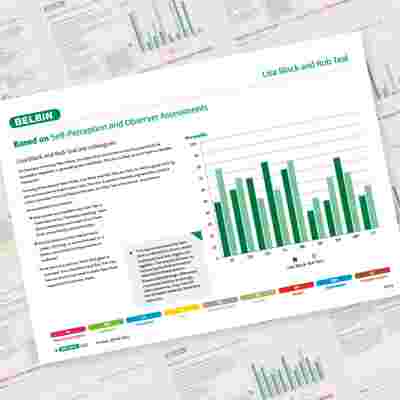What about pairs?
Some work requires more resources than an individual has to offer, but is not best served by a team.
There are many tools to help make individuals and teams more effective, but what about pairs?
Some work requires more resources than an individual has to offer, but is not best served by a team.
There are many tools to help make individuals and teams more effective, but what about pairs?
Organisations are increasingly seeing the benefits of colleagues working in twos.
For example, in the technique called pair programming, two computer programmers work together, one (the “driver”) writing the code and the other (the “navigator”) reviewing the code and keeping an eye to the overall direction of the work.
(In Belbin Team Role terms, this allows the driver to play the Implementer and Specialist, whilst the navigator acts as Co-ordinator, Monitor Evaluator and Completer Finisher.)
Working in pairs can allow two people to share responsibility without too many viewpoints spoiling the proverbial broth.
This can work well for individuals with lower profiles, who might defer to others in a team, but have the confidence to voice their opinions when working closely with just one colleague.
So how do you place people in pairs? There are a number of – potentially competing – factors to consider.
Given the principle of achieving Team Role balance, we might assume that the optimal pairing would be of individuals with opposite Team Role preferences.
However, in order to identify with one another and work well together, there should also be some commonality of Team Role behaviour so that the working style and approach of each person is not entirely alien to the other.


Team Roles can be grouped into three categories:
It is important that these areas are covered by one or other of the pair, to ensure a holistic approach to any project. Again, some common ground can also be useful.
Just as it is vital to avoid too many gaps in Team Role coverage, it is also important that the pair do not have too many Team Roles in common.
If this is the case, they may become territorial over the jobs both enjoy, whilst avoiding the work which relates to their least preferred roles.


A particular Team Role combination which works well for two colleagues may not be so effective if one of the pair manages the other, since other expectations come into play.
Additionally, Team Role relationships are not symmetrical. In other words, given the Team Role strengths, there may be combinations which work better with Person A managing Person B rather than vice versa.
Belbin offers a work pair profile – called the Working Relationship report – which analyses how pairs might work together.
The report highlights the differences between two people, and takes into account their professional relationship – you can stipulate one candidate as the manager of the other or both as colleagues.
The report includes some questions to be considered if those two individuals are working together. Obviously there are a lot of other factors which may come into play, but the report provides some initial ideas, as well as some points for discussion.
As such, the report is ideal for introducing new working pairs, and for helping existing colleagues to diagnose and defuse problems before they become more widespread.
The Belbin Working Relationship report compares two people on the basis of top and second Team Roles.

The commentary indicates that John will need to give Jan space for independent thought and creativity, owing to Jan’s high Plant score and John’s Shaper tendencies. If Jan is able to align her ideas with John’s goals, however, the partnership is likely to be successful.
On the basis of second Team Roles, the picture is more encouraging. John and Jan share a second Team Role of Resource Investigator, so are likely to understand one another’s outgoing, resourceful approach.
However, it is important to note that neither individual displays prominent Monitor Evaluator or Completer Finisher behaviours, so it is distinctly possible that they will neglect an error (whether macro or micro) which could prove detrimental.
Of course, the significance of this depends on the work the pair is being asked to do. If they are scouting for new opportunities or ideas to take back to the team, this is unlikely to be a problem. However, if they are taking a project from start to finish, these missing roles may require careful consideration.
The report suggests that they are likely to work well together in a creative capacity, owing to their high Plant and Resource Investigator scores respectively. Their secondary roles are also a good match, with Rob planning (Monitor Evaluator) and Lisa taking practical action (Implementer).
This pair covers a good number of Team Role behaviours between them. The only missing role is Specialist, which might be outsourced if needed for the project in question.

Join over 25,000 people who receive our research and insights once a week. Unsubscribe any time.
Dr Meredith Belbin described how Team Roles can improve working relationships between colleagues:
Sunny and Ali worked in the Marketing and Sales division of a large utility company. Sunny was the Head of Marketing and Sales and Ali was the Marketing Manager who reported to Sunny.
The two were experiencing some problems working together and their working relationship had been deteriorating for some time.
Sunny had appointed Ali because he seemed to take a different approach and wasn’t constrained by the organisational culture. He produced innovative ideas and excelled at networking and building rapport with existing and potential clients. He enjoyed autonomy in his work, but sometimes Sunny perceived his approach as maverick – ‘a loose cannon’.
Sunny was responsible for presenting sales progress reports (written by Ali) to her Director. The Director required detail in every report and Sunny was known for accuracy and eager to protect her relationship with the Director.
She judged that Ali’s reports were lacking in detail, so tended to refine them before passing them on. Ali was annoyed by this behaviour, perceiving Sunny as a ‘control freak’.
The relationship had deteriorated to the point where Sunny felt that, despite his obvious talents, Alan must change or leave.
Sunny’s Completer Finisher and Shaper strengths explain her combination of attention to detail and push for things to be done in the right way.
However, taken too far, this was perceived by Ali as fussiness and reluctance to delegate. She didn’t trust Ali to do the job properly, so she did it again herself.
Ali’s combination of strengths meant that he was good at generating and trying out new ideas, and enjoyed a fair degree of autonomy to use his initiative. However, he was easily bored by detail and somewhat impulsive in his behaviour.
To improve the relationship, Sunny needed to allow Ali to play his Plant and Resource Investigator roles and give greater recognition to the value of those contributions. In asking him to produce the detailed reports, she was essentially forcing him to play his weakest roles.
In turn, Ali needed to recognise that Sunny’s strengths were complementary to his, which, in theory, made them an effective pair.
It was discovered that Ali’s team contained three people with Completer Finisher strengths, who were ideally placed to produce the kind of report Sunny needed. It was agreed that one of those team members would focus on the detail of the report (liaising directly with Sunny) and Ali would provide the overview.
To learn more about Team Roles in general, why not join us on a practical day for an introduction to all things Belbin, including the Working Relationships reports.
For more detailed information about the Working Relationship reports, click here.

Before you can analyse your teams, you need to look at each individual's contribution. So, the first thing you will need to do is to generate a Belbin Individual report for each member of the team.
Find out more
Whether you're forming a new team, introducing new people to an existing team, or trying to resolve issues within a team, a Belbin Team report can help you to manage it.
Discover more
Belbin Team Roles are used to identify behavioural strengths and weaknesses in the workplace. Whether developing people, resolving conflict or fine-tuning high performance...
Read moreJoin over 25,000 people who receive our research and insights once a week. Unsubscribe any time.